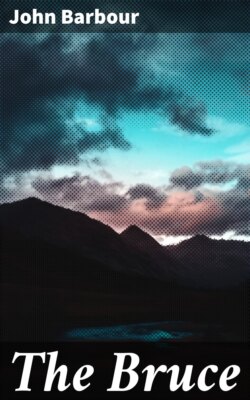Читать книгу The Bruce - Barbour John - Страница 5
На сайте Литреса книга снята с продажи.
2. The Scribes.
ОглавлениеTable of Contents
The Cambridge MS. bears witness that it was completed on August 18, 1487, by the hand of “John de R., chaplain”; the Edinburgh MS. that it was “hurriedly written” by “John Ramsay” in 1489, for a Fife vicar; and the latter signature is attached to the only MS. of The Wallace, which accompanies that of The Bruce but was transcribed two years earlier. Skeat immediately pronounces that the names signify but one person, that “John de R.” is also “John Ramsay,” apparently on the logic of Wonderland, because both surnames begin with the same letter.[13] Mr. Brown, however, points out that this equation of alternative forms was highly improbable for fifteenth-century Scotland, and substitutes a reading of his own whereby the scribes are still merged in one personality as “John Ramsay” otherwise “Sir John the Ross,” one of Dunbar’s makars, the real author of The Wallace, and the wholesale redactor of The Bruce. The details of Mr. Brown’s argument and all that flows therefrom must be read in The Wallace and The Bruce Restudied.[14] Mr. Brown (if I may say so) never fails to be suggestive and interesting, and even the light which led him astray was real critical illumination; but John Ramsay, who, “as a chaplain”—which he does not claim to have been—“was entitled to the courtesy title of Sir,”[15] and took his alternative name from his office as “Ross Herald or Ross Secretary”;[16] who lightened the toil of transcribing Acts of Parliament by dropping into verse on the margin—an unjustifiable accusation;[17] and who, from the seed of Blind Harry’s “gests,” raised the prickly bloom of The Wallace, and grafted enough borrowed material on to the rough stock of the original Bruce to make it something substantially different, and did all this without leaving even a cipher as a hint to posterity—of this complex and composite personage Mr. Brown is the only begetter, and his brief and inglorious career may be followed in The Athenæum, November 17-December 8, 1900, February 9, 1901. Mr. Brown, of course, can still claim that the problem of late redaction remains, whoever the guilty one may have been.[18] On this understanding I deal with it elsewhere.[19]
For the MSS., it needs but a slight examination to show that they are from different hands. The fifteenth century had no “consistent orthography,” but a scribe would probably have of himself; would not, at the least, exhibit the systematic differences that mark the MSS. in question. That the differences are due to the scribes is indicated by their occurrence even in proper names where E is, on the whole, much more accurate than C.[20] Add that C offers more traces of southern English influences; that it invariably gives the weak form I for the Ic or Ik of E, and substitutes can for the latter’s gan; that it regularly prefers of to the off which distinguishes E and in certain positions i for y—these with other minor peculiarities, not being vital in character, are certainly due to individual idiosyncrasies in spelling. Ramsay is an honest scribe, who, at places, cannot read his original, and leaves a blank which must be supplied from the copy of the chaplain.[21] There is thus not the faintest reason for supposing but one scribe to have been at work. At the same time the essential agreement of the two transcripts shows that we are dealing with a single, complete, familiar poem which has suffered in precision of copying from the usual mishaps incident to its manner of publication and preservation.
